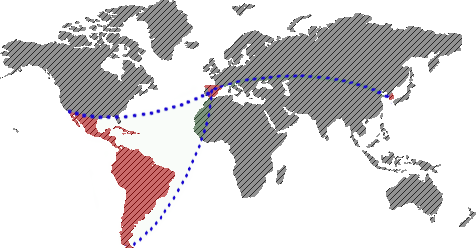The programs of several Latin American countries to send more students to US universities are beginning to bear fruit, even if the number of Latin American students in schools in US higher education remains far below that of China, India, Korea South and even Vietnam.
Brazil, whose government launched three years ago a program to send 100,000 university to study science at foreign universities students, was one of the countries that most increased its number of students in US universities, according to a new study by the Institute of International Education (IEI), headquartered in New York.
According to the study of IEI, entitled "Open doors", this year an increase of 22.2 percent of Brazilian students in American universities was recorded. That brought up the Decomo Brazil among the countries with the highest number of foreign students in US universities, only one post after Mexico.
The rapid rise of Brazilian students in US universities is a direct result of the "Without Borders Sciences" of the Brazilian government, which aims to send 100,000 students to the best universities in the world to study science and engineering, under the premise that it is imperative that have an international education. There are currently 13,300 Brazilian students in US universities, according to the related estudio.Contenido Brazil has followed in the footsteps of Chile, almost a decade launched a similar program of study abroad ago. Earlier this year Mexico launched its plan "Projects 100,000" to dramatically increase the number of students in universities in the United States, Europe and elsewhere, from the current 14.800 to 100.000 in the next four years.
However, the number of Latin American students in US universities is still much lower than that of Asian students.
There are 274,000 Chinese students in American universities, 103,000 in India, 68,000 in South Korea, Saudi Arabia 54,000, 28,300 in Canada, 21,300 in Taiwan, 19,300 in Japan and 16,600 in Vietnam, according to new figures "open doors" .
Mexico and Brazil come immediately following Vietnam, with less than 15,000, and most other Latin American countries occupy much lower positions. Colombia There are 7,100 students in the universities of the United States, Venezuela 7,000, 2,600 of Peru, Ecuador 2,500, 2,400 and 1,900 of Argentina Chile, according to the study.
However, IEI officials say they are confident that the number of Latino students in American universities will rise faster in the coming years. They say the numbers will increase thanks to the programs of study abroad in Brazil and Mexico, and also due to the program "100,000 in the Americas" President Barack Obama, seeking to increase the flow of Latin American students at US universities - and vice versa, to Latin American students - to reach 100,000 in each direction in 2020. "just beginning to see the impact of scientific mobility program in Brazil," says the president of IEI, Allan E. Goodman. "And we are seeing large increases in the number of students in Peru, Costa Rica and Venezuela".
While the study "Open Doors" shows an increase of 8.2 percent in the number of Latinos in American universities this year, there was an increase of only 1.8 percent in the number of US students going to Latin America.
While 53 percent of US students going to study abroad choose European countries such as England and France, only 15 percent selected Latin American countries.
My opinion: One of the biggest obstacles to achieving higher levels of student mobility in Latin America is the fear of "brain drain". Some Latin American countries have not yet noticed that in today's globalized world, the concept of "brain drain" is somewhat dated.
China, India, South Korea and other countries have sent hundreds of thousands of students at American universities in recent decades have benefited greatly from the student diaspora. Some of its graduates in American universities have returned to their home countries as highly skilled frontline academics or professionals, while many of those who have remained in the United States are helping their countries of origin as visitors or inversionistas.Afortunadamente teachers, Brazil, Chile and Mexico have recently warned that the old concept of "brain drain" has been replaced by the "brain circulation". They are beginning to emerge from decades of academic isolation. Other countries could join them soon, and we could see how Latin America benefits from the "brain circulation" as much as have Asian countries in recent years.





